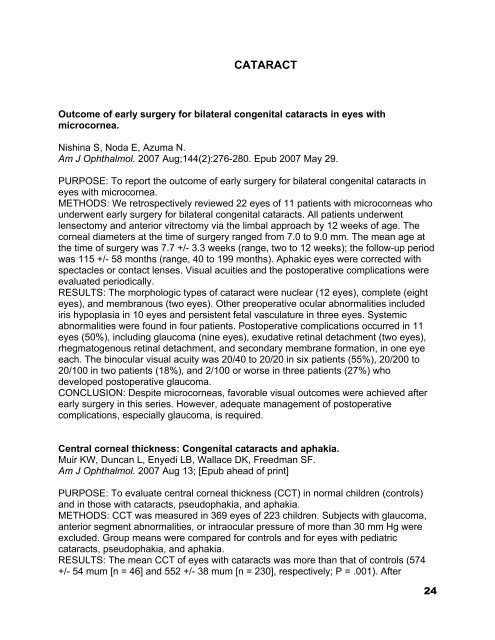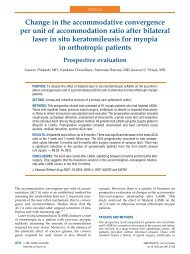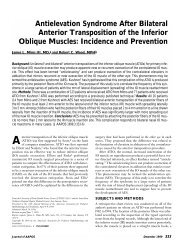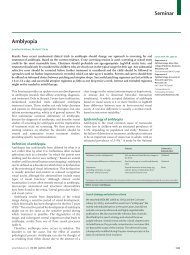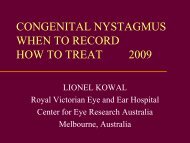What's new AAPOS 2008 - The Private Eye Clinic
What's new AAPOS 2008 - The Private Eye Clinic
What's new AAPOS 2008 - The Private Eye Clinic
Create successful ePaper yourself
Turn your PDF publications into a flip-book with our unique Google optimized e-Paper software.
CATARACT<br />
Outcome of early surgery for bilateral congenital cataracts in eyes with<br />
microcornea.<br />
Nishina S, Noda E, Azuma N.<br />
Am J Ophthalmol. 2007 Aug;144(2):276-280. Epub 2007 May 29.<br />
PURPOSE: To report the outcome of early surgery for bilateral congenital cataracts in<br />
eyes with microcornea.<br />
METHODS: We retrospectively reviewed 22 eyes of 11 patients with microcorneas who<br />
underwent early surgery for bilateral congenital cataracts. All patients underwent<br />
lensectomy and anterior vitrectomy via the limbal approach by 12 weeks of age. <strong>The</strong><br />
corneal diameters at the time of surgery ranged from 7.0 to 9.0 mm. <strong>The</strong> mean age at<br />
the time of surgery was 7.7 +/- 3.3 weeks (range, two to 12 weeks); the follow-up period<br />
was 115 +/- 58 months (range, 40 to 199 months). Aphakic eyes were corrected with<br />
spectacles or contact lenses. Visual acuities and the postoperative complications were<br />
evaluated periodically.<br />
RESULTS: <strong>The</strong> morphologic types of cataract were nuclear (12 eyes), complete (eight<br />
eyes), and membranous (two eyes). Other preoperative ocular abnormalities included<br />
iris hypoplasia in 10 eyes and persistent fetal vasculature in three eyes. Systemic<br />
abnormalities were found in four patients. Postoperative complications occurred in 11<br />
eyes (50%), including glaucoma (nine eyes), exudative retinal detachment (two eyes),<br />
rhegmatogenous retinal detachment, and secondary membrane formation, in one eye<br />
each. <strong>The</strong> binocular visual acuity was 20/40 to 20/20 in six patients (55%), 20/200 to<br />
20/100 in two patients (18%), and 2/100 or worse in three patients (27%) who<br />
developed postoperative glaucoma.<br />
CONCLUSION: Despite microcorneas, favorable visual outcomes were achieved after<br />
early surgery in this series. However, adequate management of postoperative<br />
complications, especially glaucoma, is required.<br />
Central corneal thickness: Congenital cataracts and aphakia.<br />
Muir KW, Duncan L, Enyedi LB, Wallace DK, Freedman SF.<br />
Am J Ophthalmol. 2007 Aug 13; [Epub ahead of print]<br />
PURPOSE: To evaluate central corneal thickness (CCT) in normal children (controls)<br />
and in those with cataracts, pseudophakia, and aphakia.<br />
METHODS: CCT was measured in 369 eyes of 223 children. Subjects with glaucoma,<br />
anterior segment abnormalities, or intraocular pressure of more than 30 mm Hg were<br />
excluded. Group means were compared for controls and for eyes with pediatric<br />
cataracts, pseudophakia, and aphakia.<br />
RESULTS: <strong>The</strong> mean CCT of eyes with cataracts was more than that of controls (574<br />
+/- 54 mum [n = 46] and 552 +/- 38 mum [n = 230], respectively; P = .001). After<br />
24


